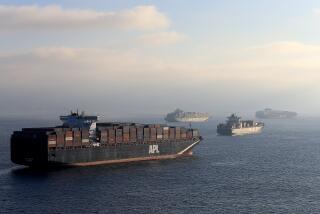What dolphin diets reveal about climate change’s effects off the California coast
- Share via
Scientists studying dolphins dining off the California coastline have found that the marine food web is starting to look a little threadbare. The length of food chains in that web appears to have gotten shorter in response to environmental changes — such as those caused by El Niño events.
The findings, published this week in the journal Science Advances, highlight a useful method for examining the ways climate change is affecting the structure of the world’s ecosystems.
As human-caused climate change continues its rapid pace, and as the oceans warm and acidify, it’s altering which marine species can survive. That means that key species in a food web may start to decline – which can have serious effects on this complex and delicate network.
Those specific effects are still something of a mystery, because the ocean’s food web is incredibly complicated. Here’s an example of one path through the web: Phytoplankton make food from sunlight, and then they’re eaten by zooplankton, which might get eaten by a small fish, which is eaten by a bigger one, and so on, through the top predator in the area, such as a dolphin or a shark.
But at each link in that food chain, there are many species that can eat or be eaten. And certain predator species compete for the same prey. And those competitors might sometimes eat one another. The result is a wackily woven web of predator-prey relationships that defies easy explanation.
“In the ocean we have a huge diversity [of species], and it’s very complex,” said lead author Rocio I. Ruiz-Cooley, a marine ecologist at Moss Landing Marine Laboratories. “Everything is dynamic.”
That’s why understanding those interconnected relationships — and how they’re being altered by climate change — is easier said than done.
Scientists have tried to get at that question by tracking the ratio of nitrogen isotopes in the system (for example, in zooplankton, the tiny critters that eat phytoplankton). In the environment, there’s a small but naturally occurring amount of a slightly heavier isotope of nitrogen.
Standard nitrogen, nitrogen-14, has seven protons and seven neutrons; the heavier version has one extra neutron, making it nitrogen-15. The share of this heavier version builds up in animal tissues the higher up in the food chain you go. (This is because the body’s systems tend to get rid of nitrogen-14 a little faster than they do nitrogen-15, so the heavier isotope tends to accumulate.)
That means the share of nitrogen-15 is slightly higher in herbivores than in plants, higher still in the carnivores that eat those herbivores, and highest in the top predator in the food chain.
Scientists often check the ratio of nitrogen-15 to nitrogen-14 in the tissues of the top predator in an ecosystem to get a sense of how the food chain is faring. Because top predators roam far and wide and often eat many different kinds of prey, their tissues often serve as a good sampling of the local environment. And since they’re at the top of the food chain, dolphins’ nitrogen-15 levels also reflect the number of links in the food chain beneath them.
The problem is that it’s hard for researchers to tell those two things apart: the heavy nitrogen that’s available from the base of the food chain, and the heavy nitrogen that reflects the length of the food chain.
Ruiz-Cooley and her colleagues found a way around this issue. They studied 204 skin samples from dolphins that were accidentally killed in fisheries in the Southern California Bight from 1991 to 2008. They looked at the nitrogen isotope ratios specifically in about a dozen different kinds of amino acids (the building blocks of proteins). Some amino acids reflect the lower nitrogen-15 levels made available by the primary producers – the phytoplankton at the base of the food chain, for example. Other amino acids, richer in nitrogen-15, clearly come from animal processes.
By measuring the difference between these two heavy-nitrogen signals – one reflecting the top of the food chain, and the other reflecting the bottom – the scientists were able to determine the length of the food chain that had ended in the dolphins.
“That way we can reconstruct how the primary producers have changed, and at the same time, how the diet of the dolphins has changed,” Ruiz-Cooley said.
The researchers found that the food chain length varied from year to year, and took a significant hit when the environment changed – for example, after the 1997-98 El Niño season, and after 2004, when the rise of a low-oxygen zone trapped many species closer to the surface than usual.
That shortening could mean that certain species went locally extinct, forcing dolphins to eat things lower down on the food chain, for example. In any case, it’s an indicator that the food web did shift in the face of environmental change.
That’s a departure from earlier work on the subject, which suggested that food webs remain largely stable in the face of such climate variation.
Climate change may bring more extreme environmental changes – and we still know relatively little about how the world’s food webs will be affected. This technique could allow researchers around the world to start taking a bite out of that mystery, Ruiz-Cooley said.
“With global warming, climate change … we need to know what is happening,” she said.
Follow @aminawrite on Twitter for more science news and “like” Los Angeles Times Science & Health on Facebook.
MORE IN SCIENCE
Fires, droughts and hurricanes: What’s the link between climate change and natural disasters?
With Obamacare, fewer Americans were uninsured when they were told they had cancer
Scientists engineer proteins that caused obese animals to lose weight and lower cholesterol







